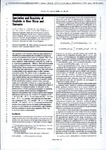Speciation and Reactivity of Cisplatin in River Water and Seawater
| dc.contributor.author | Curtis, L | |
| dc.contributor.author | Turner, A | |
| dc.contributor.author | Vyas, N | |
| dc.contributor.author | Sewell, G | |
| dc.date.accessioned | 2015-10-27T16:14:43Z | |
| dc.date.available | 2015-10-27T16:14:43Z | |
| dc.date.issued | 2010-05-01 | |
| dc.identifier.issn | 0013-936X | |
| dc.identifier.issn | 1520-5851 | |
| dc.identifier.uri | http://hdl.handle.net/10026.1/3707 | |
| dc.description.abstract |
The adsorption of the cytostatic anticancer drug, cisplatin (cis-PtCl(2)(NH(3))(2)), has been studied after its addition to suspensions of estuarine sediment in river water and seawater. After a 16 h reaction period, adsorption was significantly greater in river water (sediment-water distribution coefficient, K(D), of 400 mL g(-1)) than that in seawater (K(D) approximately 150 mL g(-1)) because of the ready aquation of cisplatin to the more reactive monoaquacisplatin (cis-PtCl(OH(2))(NH(3))(2)(+)) at low chloride ion concentrations. Adsorption in river water was enhanced (K(D) approximately 2000 mL g(-1)) by a 24 h period of preincubation in the aqueous phase in which aquation proceeded further. The effects of pH on adsorption were relatively small, presumably because protonation-deprotonation of the particle surface was accompanied by near-equivalent shifts in the charge of hydrolysis products of aquated cisplatin. Kinetic experiments revealed a period of slow protracted uptake (up to about 60 h), followed by gradual desorption in both river water and seawater. Results were interpreted in terms of the formation of monoaquacisplatin, its adsorption to the particle surface, and the subsequent desorption of undefined, unreactive species. Kinetic data were modeled with a sequence of pseudofirst-order reactions and fits were obtained with forward and reverse rate constants for aquation of 1.79 x 10(-5) and 1.84 x 10(-5) s(-1) in river water and 5.50 x 10(-6) and 5.84 x 10(-6) s(-1) in seawater, and adsorption and desorption rate constants of 1.75 x 10(-5) and 0.20 x 10(-5) s(-1) in river water and 0.98 x 10(-5) and 2.8 x 10(-5) s(-1) in seawater. Environmental conditions favoring the retention of cisplatin and its degradation products are low chloride ion concentrations, high turbidities, and long residence or transit times; dispersion of the drug is favored in saline, coastal waters. | |
| dc.format.extent | 3345-3350 | |
| dc.format.medium | ||
| dc.language | en | |
| dc.language.iso | eng | |
| dc.publisher | American Chemical Society (ACS) | |
| dc.subject | Adsorption | |
| dc.subject | Chlorides | |
| dc.subject | Cisplatin | |
| dc.subject | Fresh Water | |
| dc.subject | Geologic Sediments | |
| dc.subject | Hydrogen-Ion Concentration | |
| dc.subject | Kinetics | |
| dc.subject | Models, Chemical | |
| dc.subject | Oceans and Seas | |
| dc.subject | Platinum | |
| dc.subject | Rivers | |
| dc.subject | Salts | |
| dc.subject | Seawater | |
| dc.subject | Time Factors | |
| dc.subject | Water Pollutants, Chemical | |
| dc.title | Speciation and Reactivity of Cisplatin in River Water and Seawater | |
| dc.type | journal-article | |
| dc.type | Article | |
| plymouth.author-url | https://www.ncbi.nlm.nih.gov/pubmed/20349990 | |
| plymouth.issue | 9 | |
| plymouth.volume | 44 | |
| plymouth.publication-status | Published | |
| plymouth.journal | Environmental Science & Technology | |
| dc.identifier.doi | 10.1021/es903620z | |
| plymouth.organisational-group | /Plymouth | |
| plymouth.organisational-group | /Plymouth/Faculty of Health | |
| plymouth.organisational-group | /Plymouth/Faculty of Science and Engineering | |
| plymouth.organisational-group | /Plymouth/Faculty of Science and Engineering/School of Geography, Earth and Environmental Sciences | |
| plymouth.organisational-group | /Plymouth/REF 2021 Researchers by UoA | |
| plymouth.organisational-group | /Plymouth/REF 2021 Researchers by UoA/UoA03 Allied Health Professions, Dentistry, Nursing and Pharmacy | |
| plymouth.organisational-group | /Plymouth/REF 2021 Researchers by UoA/UoA03 Allied Health Professions, Dentistry, Nursing and Pharmacy/UoA03 Allied Health Professions, Dentistry, Nursing and Pharmacy MANUAL | |
| plymouth.organisational-group | /Plymouth/REF 2021 Researchers by UoA/UoA07 Earth Systems and Environmental Sciences | |
| plymouth.organisational-group | /Plymouth/Research Groups | |
| plymouth.organisational-group | /Plymouth/Research Groups/BEACh | |
| plymouth.organisational-group | /Plymouth/Research Groups/Institute of Health and Community | |
| plymouth.organisational-group | /Plymouth/Research Groups/Marine Institute | |
| plymouth.organisational-group | /Plymouth/Users by role | |
| plymouth.organisational-group | /Plymouth/Users by role/Academics | |
| dc.publisher.place | United States | |
| dc.identifier.eissn | 1520-5851 | |
| dc.rights.embargoperiod | Not known | |
| rioxxterms.versionofrecord | 10.1021/es903620z | |
| rioxxterms.licenseref.uri | http://www.rioxx.net/licenses/all-rights-reserved | |
| rioxxterms.type | Journal Article/Review |


